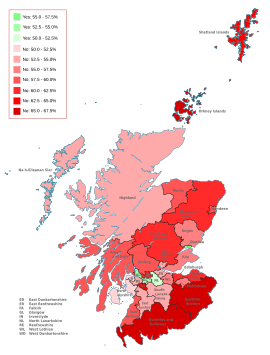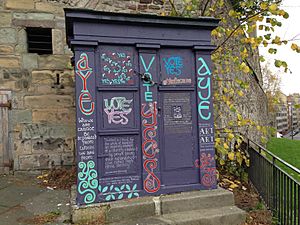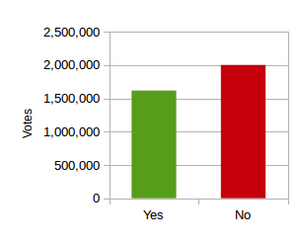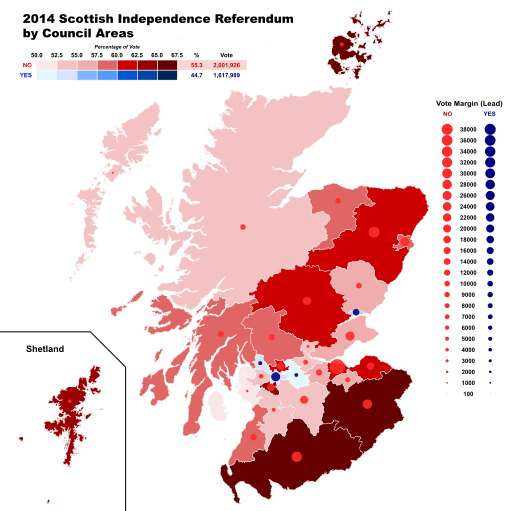2014 Scottish independence referendum facts for kids
| Should Scotland be an independent country? | ||||||||||||||||||||||
| Date | 18 September 2014 | |||||||||||||||||||||
|---|---|---|---|---|---|---|---|---|---|---|---|---|---|---|---|---|---|---|---|---|---|---|
|
||||||||||||||||||||||
|
||||||||||||||||||||||
| Note: saturation of colour denotes strength of vote | ||||||||||||||||||||||
On September 18, 2014, people in Scotland voted in a special election called a referendum. They were asked one big question: "Should Scotland be an independent country?" Voters could choose "Yes" or "No".
The "No" side won. About 2 million people (55.3%) voted against independence. Around 1.6 million people (44.7%) voted for it. A huge number of people voted, with 84.6% of eligible voters taking part. This was one of the highest turnouts for an election in the United Kingdom in over 100 years.
The rules for the referendum were set by the Scottish Independence Referendum Act 2013. This law was passed by the Scottish Parliament after an agreement with the UK government. To become independent, the "Yes" side just needed more than half of the votes.
Anyone aged 16 or older living in Scotland could vote if they were a citizen of the European Union (EU) or the Commonwealth. This was the first time 16 and 17-year-olds could vote in Scotland. Nearly 4.3 million people were able to vote.
Two main groups led the campaigns. Yes Scotland wanted independence. Better Together wanted Scotland to stay part of the UK. Many other groups, political parties, and famous people also got involved. Big topics discussed included what money Scotland would use, how much the government would spend, if Scotland would stay in the EU, and the future of North Sea oil.
Contents
Understanding the Referendum: A Quick Look
How Did Scotland and the UK Form?
Scotland and England were separate countries for a long time. They fought wars in the 1300s. In 1603, their kings became the same person. This was called the Union of the Crowns. Later, in 1707, Scotland and England officially joined to form the Kingdom of Great Britain. This happened because Scotland had money problems, and England wanted to make sure their royal family line was secure. In 1801, Great Britain joined with Ireland to form the United Kingdom. Most of Ireland left in 1922. Since 1927, the country has been called the United Kingdom of Great Britain and Northern Ireland.
What is Devolution?
Devolution means giving some power from the main government to local governments. In the 1920s, the Labour Party wanted Scotland to have more control over its own affairs. The Scottish National Party (SNP) was formed in 1934. They wanted Scotland to have more power.
In 1979, there was a vote about creating a Scottish Assembly. Most people voted "Yes," but not enough to meet a special rule. So, it didn't happen.
Then, in 1997, another vote was held. This time, a clear majority voted for a Scottish Parliament. They also voted for this Parliament to have some power over taxes. The Scotland Act 1998 created the new Scottish Parliament. It was first elected in 1999. This Parliament can make laws on many matters within Scotland.
The SNP and the Idea of a Vote
In 2007, the SNP won the most seats in the Scottish Parliament. Their leader, Alex Salmond, became the First Minister. The SNP had promised to hold an independence referendum in their election plan.
The SNP government started a "National Conversation" in 2007. This was a way to ask people what they thought about Scotland's future. They even published a draft law for a referendum. This draft law talked about different options for Scotland, including full independence. However, the SNP couldn't get enough support from other parties to pass the law at that time.
The 2011 SNP Government and the Vote Plan
The SNP won the 2011 Scottish Parliament election. They again promised to hold an independence referendum. UK Prime Minister David Cameron said he would campaign for Scotland to stay in the UK.
In 2012, the UK government offered to give the Scottish Parliament the legal power to hold a referendum. They wanted it to be "fair, legal and decisive." After talks, the two governments signed the Edinburgh Agreement in October 2012. This agreement allowed Scotland to hold the vote.
The Scottish Parliament then passed the Scottish Independence Referendum Act 2013. In November 2013, the Scottish government published a long document called Scotland's Future. This paper explained why they believed Scotland should be independent and how it could happen.
How the Referendum Worked
When Was the Vote?
The Scottish Government announced that the referendum would be held on Thursday, September 18, 2014. Some people noted that 2014 was a special year. It was the 700th anniversary of the Battle of Bannockburn. Scotland also hosted the 2014 Commonwealth Games and the 2014 Ryder Cup that year.
Who Could Vote?
The rules for voting were clear. You could vote if you were:
- A British citizen living in Scotland.
- A citizen of another Commonwealth country living in Scotland.
- A citizen of another European Union country living in Scotland.
- A member of the House of Lords living in Scotland.
- Military or government staff serving in the UK or overseas, registered to vote in Scotland.
People in prison could not vote. The voting age was lowered from 18 to 16 for this referendum. This was an SNP policy supported by other parties. Some people wanted Scots living outside Scotland to vote, but this was not allowed. The Scottish government said it would make the vote too complicated.
Was the Vote Legal?
There was some discussion about whether the Scottish Parliament had the power to hold a vote on independence. The UK constitution is usually controlled by the UK Parliament. However, the Edinburgh Agreement temporarily gave the Scottish Parliament the power to hold this specific vote. This made the referendum fully legal.
Who Watched Over the Vote?
The Electoral Commission was in charge of making sure the referendum was fair. They oversaw the campaigns and how money was spent. Local officials managed the actual voting and counting.
What Was the Question?
The Scottish government first suggested the question: "Do you agree that Scotland should be an independent country?" But the Electoral Commission tested it. They found that "Do you agree" made it sound like they wanted a "Yes" answer. So, the question was changed to "Should Scotland be an independent country?" This was seen as more neutral and clear.
Campaign Groups and Money
The two main campaign groups were Yes Scotland and Better Together. They were allowed to spend up to £1.5 million each. Political parties also had spending limits. Many other groups could register and spend smaller amounts. The total cost of running the referendum was about £15.85 million.
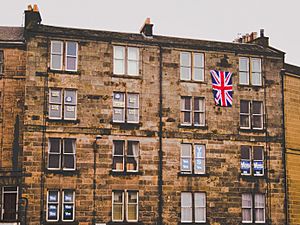
- Yes Scotland started in May 2012. Its leader was Blair Jenkins. The SNP and Scottish Green Party supported it. They wanted one million people to sign a declaration for independence. They reached this goal in August 2014.
- Better Together started in June 2012. It was led by Alistair Darling. The Conservative, Labour, and Liberal Democrat parties supported it.
Both campaigns received large donations. For example, author J. K. Rowling gave £1 million to Better Together. Lottery winners Chris and Colin Weir gave £3.5 million to Yes Scotland.
How Did People Vote?
People could vote by mail starting in late August 2014. The deadline to register to vote was September 2. Many councils reported a huge number of new registrations. On September 18, people voted at special places like schools and community centers. Voting was open from 7 AM to 10 PM.
What Would Happen After the Vote?
If "Yes" won, Scotland would become independent after talks with the UK. If "No" won, Scotland would stay in the UK. The UK government promised to give more powers to the Scottish Parliament if "No" won. Both sides agreed to accept the result. Alex Salmond called it a "once in a generation" event.
Key Issues Discussed During the Campaign
Money Matters: The Economy
The economy was a huge topic.
- Businesses: Some big companies like Standard Life said they might move parts of their business out of Scotland if it became independent. This was to avoid extra costs and rules.
- GDP and Debt: Scotland's economy per person was similar to or better than some European countries. However, there were questions about how Scotland would manage its finances and share the UK's debt.
- Banking: The UK Treasury worried that Scotland's banking system would be too big for a small country to support if a bank failed. Several major banks said they would move their official headquarters to England if Scotland became independent.
What Money Would Scotland Use?
This was one of the biggest debates.
- Keeping the Pound: The SNP wanted an independent Scotland to keep using the pound sterling in a formal currency union with the UK. This would mean the Bank of England would still control interest rates.
- UK's View: The UK government, including the Chancellor George Osborne, said they would not agree to a currency union. They argued it would not work and would mean Scotland losing control over its own money policies.
- Other Options: Some suggested Scotland could create its own currency or join the euro. But these options also had challenges. The governor of the Bank of England, Mark Carney, said a currency union would be "incompatible with sovereignty."
Government Money and Spending
Scotland received more public spending per person than England. This was partly due to a system called the Barnett formula.
- Oil Revenue: Most of the UK's North Sea oil is in Scottish waters. The SNP believed an independent Scotland would get more tax money from this oil. They also wanted to create a special oil fund, like Norway has. However, oil prices can change a lot.
- Costs of Independence: The UK government estimated it would cost about £1.5 billion to set up an independent Scottish state. The Scottish government said it was hard to estimate without negotiations.
Energy: Powering Scotland
- Energy Market: Scotland wanted to keep a single energy market with the rest of Great Britain. This would help keep prices stable.
- Renewable Energy: Scotland has a lot of renewable energy, like wind power. There were concerns that independence might lead to higher energy bills in Scotland if it had to pay for these projects alone.
- North Sea Oil: About 90% of the UK's North Sea oil fields are in Scottish waters. The SNP believed Scotland would benefit greatly from these revenues. However, experts disagreed on how much oil was left and how long it would last.
Scotland and the European Union (EU)
- Membership: The SNP wanted an independent Scotland to be a full member of the EU. They hoped to keep some of the UK's special rules, like not having to use the euro.
- Rejoining the EU: There was a big debate about whether Scotland would have to reapply to join the EU. The European Commission president, José Manuel Barroso, said it would be "extremely difficult, if not impossible" for Scotland to join quickly. Some countries, like Spain, worried about their own regions wanting independence.
- UK's EU Vote: The UK government had promised a vote on whether the UK should stay in the EU by 2017. Many in Scotland wanted to stay in the EU, while more people in England wanted to leave. This made the independence vote even more complicated.
Healthcare: NHS Scotland
Healthcare in Scotland was already managed by the Scottish Parliament. Scotland had different policies, like free prescriptions.
- Funding: Supporters of independence said it would protect NHS Scotland from cuts and privatization happening in England. Opponents worried that independence would mean less funding for Scotland's NHS.
- Specialist Care: There were concerns about Scots getting specialist treatment in other parts of the UK, like at Great Ormond Street Hospital in London. However, hospitals often have agreements for patients from different countries.
Defense: Protecting Scotland
- Military Size: The SNP planned for an independent Scotland to have a military of about 15,000 regular troops and 5,000 reserves. Critics said this budget was too small.
- Nuclear Weapons: The UK's nuclear weapons, called Trident, are based in Scotland. The SNP wanted them removed. British military leaders said there was no other place for them in the UK. Moving Trident would be very expensive and take a long time.
- NATO: The SNP wanted an independent Scotland to join NATO, a military alliance. However, NATO is a nuclear alliance, and Scotland wanted to be nuclear-free. This caused some debate.
Education: Universities and Students
- Research Funding: Scottish universities received a lot of research money from UK-wide funds. There were worries that independence would mean losing this funding.
- Student Fees: Students from Scotland did not pay tuition fees at Scottish universities. Students from the rest of the UK did. If Scotland became independent, students from the rest of the UK might be treated like other EU students, meaning they wouldn't pay fees either. This could cost Scottish universities money.
How People Reacted
Public Events and Rallies
Both sides held many public events.
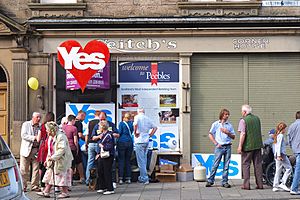

- Yes Rallies: Thousands of people marched for independence in cities like Edinburgh.
- No Rallies: The Orange Order held a large anti-independence march in Edinburgh. A "Let's Stay Together" rally was held in London's Trafalgar Square.
- Campaign Incidents: Labour MP Jim Murphy faced some angry protests during his "No" campaign tour. He was even hit by an egg.
Online Campaigns
Both campaigns used social media a lot.
- Yes Scotland was very active online, gaining more followers on Facebook and Twitter.
- No Because campaigns also appeared.
- Celebrities made videos for both sides.
Televised Debates
There were several TV debates. The most watched were between Alex Salmond (Yes) and Alistair Darling (No).
- The first debate was on August 5, 2014. A quick poll after the debate suggested Darling won.
- The second debate was on August 25, 2014. A quick poll after this debate suggested Salmond won.
Accusations of Bias
Some independence supporters accused the BBC of being biased against independence. They held protests outside BBC offices. The BBC said its coverage was fair and neutral.
Intimidation Reports
Some business leaders who supported staying in the UK said they felt pressured or intimidated by "Yes" campaigners. There were also reports of online abuse towards journalists.
What the Polls Said
For most of the campaign, polls showed that the "No" side was ahead. In early September 2014, a poll showed the "Yes" side slightly ahead for the first time. This made the vote seem much closer. However, the final polls before the vote showed "No" leading by a small amount. No exit poll was done on the day of the vote.
How the Votes Were Counted
Counting the Ballots
Counting started after polls closed at 10 PM. Votes from Scotland's 32 local areas were counted separately. The first result came from Clackmannanshire, and the last from Highland.
The Final Results
The "No" side won with 55.3% of the votes. The turnout was 84.6%, which was very high. 28 of Scotland's 32 local areas voted "No." However, the four areas that voted "Yes" (Dundee, Glasgow, North Lanarkshire, and West Dunbartonshire) had a large number of voters.
| Local authority | Yes votes | No votes | Yes (%) | No (%) | Valid votes | Turnout (%) |
|---|---|---|---|---|---|---|
| Aberdeen | 59,390 | 84,094 | 41.4% | 58.6% | 143,484 | 81.7% |
| Aberdeenshire | 71,337 | 108,606 | 39.6% | 60.4% | 179,943 | 87.2% |
| Angus | 35,044 | 45,192 | 43.7% | 56.3% | 80,236 | 85.7% |
| Argyll and Bute | 26,324 | 37,143 | 41.5% | 58.5% | 63,467 | 88.2% |
| Clackmannanshire | 16,350 | 19,036 | 46.2% | 53.8% | 35,386 | 88.6% |
| Dumfries and Galloway | 36,614 | 70,039 | 34.3% | 65.7% | 106,653 | 87.5% |
| Dundee | 53,620 | 39,880 | 57.3% | 42.7% | 93,500 | 78.8% |
| East Ayrshire | 39,762 | 44,442 | 47.2% | 52.8% | 84,204 | 84.5% |
| East Dunbartonshire | 30,624 | 48,314 | 38.8% | 61.2% | 78,938 | 91.0% |
| East Lothian | 27,467 | 44,283 | 38.3% | 61.7% | 71,750 | 87.6% |
| East Renfrewshire | 24,287 | 41,690 | 36.8% | 63.2% | 65,977 | 90.4% |
| Edinburgh | 123,927 | 194,638 | 38.9% | 61.1% | 318,565 | 84.4% |
| Eilean Siar | 9,195 | 10,544 | 46.6% | 53.4% | 19,739 | 86.2% |
| Falkirk | 50,489 | 58,030 | 46.5% | 53.5% | 108,519 | 88.7% |
| Fife | 114,148 | 139,788 | 45.0% | 55.0% | 253,936 | 84.1% |
| Glasgow | 194,779 | 169,347 | 53.5% | 46.5% | 364,126 | 75.0% |
| Highland | 78,069 | 87,739 | 47.1% | 52.9% | 165,808 | 87.0% |
| Inverclyde | 27,243 | 27,329 | 49.9% | 50.1% | 54,572 | 87.4% |
| Midlothian | 26,370 | 33,972 | 43.7% | 56.3% | 60,342 | 86.8% |
| Moray | 27,232 | 36,935 | 42.4% | 57.6% | 64,167 | 85.4% |
| North Ayrshire | 47,072 | 49,016 | 48.9% | 51.1% | 96,088 | 84.4% |
| North Lanarkshire | 115,783 | 110,922 | 51.1% | 48.9% | 226,705 | 84.4% |
| Orkney | 4,883 | 10,004 | 32.8% | 67.2% | 14,887 | 83.7% |
| Perth and Kinross | 41,475 | 62,714 | 39.8% | 60.2% | 104,189 | 86.9% |
| Renfrewshire | 55,466 | 62,067 | 47.2% | 52.8% | 117,533 | 87.3% |
| Scottish Borders | 27,906 | 55,553 | 33.4% | 66.6% | 83,459 | 87.4% |
| Shetland | 5,669 | 9,951 | 36.3% | 63.7% | 15,620 | 84.4% |
| South Ayrshire | 34,402 | 47,247 | 42.1% | 57.9% | 81,649 | 86.1% |
| South Lanarkshire | 100,990 | 121,800 | 45.3% | 54.7% | 222,790 | 85.3% |
| Stirling | 25,010 | 37,153 | 40.2% | 59.8% | 62,163 | 90.1% |
| West Dunbartonshire | 33,720 | 28,776 | 54.0% | 46.0% | 62,396 | 87.9% |
| West Lothian | 53,342 | 65,682 | 44.8% | 55.2% | 119,024 | 86.2% |
| Scotland | 1,617,989 | 2,001,926 | 44.7% | 55.3% | 3,619,915 | 84.6% |
What Happened After the Vote?
Reactions to the Result
- Queen Elizabeth II said everyone in the UK would respect the result.
- Prime Minister David Cameron was "delighted" Scotland stayed in the UK.
- Alex Salmond, Scotland's First Minister, accepted the "verdict of the people." He resigned as SNP leader and First Minister.
- Leaders from Northern Ireland and Wales were also happy with the result.
- Many countries around the world, including the US, Canada, Germany, and Italy, congratulated Scotland on the democratic vote.
Voting Concerns
There were a few reports of problems during the vote count, like people claiming someone else voted in their name. However, officials said the referendum was "properly conducted" and that any issues could be explained.
More People Join Political Parties
After the referendum, thousands of people joined the SNP, Scottish Greens, and Scottish Socialist Party. These parties had all supported independence. The SNP's membership tripled, making it the third-largest political party in the UK.
More Powers for Scotland
Before the vote, the leaders of the three main UK political parties promised to give "extensive new powers" to the Scottish Parliament if Scotland voted "No." An all-party group was set up to make this happen. A new law, the Scotland Act 2016, was passed to give Scotland more control over things like taxes.
Future Political Changes
- SNP Success: After the referendum, the SNP became very popular. In the 2015 UK general election, they won 56 out of 59 seats in Scotland.
- Brexit and New Referendum Calls: In 2016, the UK voted to leave the European Union (Brexit). Most people in Scotland voted to stay in the EU. Because of this, First Minister Nicola Sturgeon announced plans to prepare for a second independence referendum.
- Later Elections: In the 2017 UK general election, the SNP lost some seats. But in the 2019 election, they won many seats back.
Images for kids
-
The Scottish First Minister, Alex Salmond, and the Deputy First Minister, Nicola Sturgeon, at the launch of the National Conversation, 14 August 2007
-
A Trident missile-armed Vanguard-class ballistic missile submarine leaving its base in the Firth of Clyde
-
Map of NATO at the time of the referendum, member states shown in dark blue
-
English language brochure produced by the Foreign and Commonwealth Office comparing the 2014 Crimean status referendum with the 2014 Scottish independence referendum.
-
Pro-independence march in Glasgow in May 2018
See also
 In Spanish: Referéndum para la independencia de Escocia de 2014 para niños
In Spanish: Referéndum para la independencia de Escocia de 2014 para niños
- Constitution of the United Kingdom
- Scottish devolution
- History of the Scottish National Party
- Politics of the United Kingdom
- Proposed second Scottish independence referendum
- Potential breakup of the United Kingdom
- Welsh independence
- Proposed Welsh independence referendum


